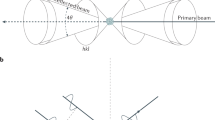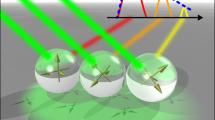Abstract
Determining crystal structures from powder X-ray diffraction data remains a challenging problem in materials science. By embedding a Le-Bail-like procedure within the recently discovered charge-flipping phasing algorithm, an extremely simple, fast and effective ab initio method has been developed to determine phases directly from indexed powder diffraction patterns. The algorithm solves the degeneracy problem by applying spherical averaging for overlapping Bragg reflections, while solving the phase problem by using the Oszlányi–Sütő charge-flipping algorithm. The processes of peak decomposition and phasing are integrated within the same iteration, and a dynamic support is used. The Fienup hybrid input–output algorithm is also incorporated to minimize stagnation. The ability of the algorithm to find structure-factor phases rapidly is found to assist with the fundamental problem of degeneracy (overlapping reflections) which is intrinsic to powder diffraction data. Space-group and chemical-composition information are not needed as inputs, and can be determined from the result. The method is illustrated using several experimental powder patterns of indifferent quality.
This is a preview of subscription content, access via your institution
Access options
Subscribe to this journal
Receive 12 print issues and online access
$259.00 per year
only $21.58 per issue
Buy this article
- Purchase on Springer Link
- Instant access to full article PDF
Prices may be subject to local taxes which are calculated during checkout




Similar content being viewed by others
References
David, W., Shankland, K., McCusker, L. & Baerlocher, Ch. (eds) Structure Determination from Powder Diffraction Data (Oxford Univ. Press, Oxford, 2002).
Juhas, P., Cherba, D. M., Duxbury, P. M., Punch, W. F. & Billinge, S. J. L. Ab initio determination of solid-state nanostructure. Nature 440, 655–658 (2006).
Rietveld, H. M. A profile refinement method for nuclear and magnetic structures. J. Appl. Crystallogr. 2, 65–71 (1969).
Young, R. A. (ed.) in The Rietveld Method (IUCr Monographs on Crystallography, Vol 5, Oxford Univ. Press, Oxford, 1993).
Oszlányi, G. & Sütő, A. Ab initio structure solution by charge flipping. Acta Crystallogr. A 60, 134–141 (2004).
Oszlányi, G. & Sütő, A. Ab initio structure solution by charge flipping II. Use of weak reflections. Acta Crystallogr. A 61, 147–152 (2005).
Le Bail, A., Duroy, H. & Fourquet, J. L. Ab-initio structure determination of LiSbWO6 by X-ray powder diffraction. Mater. Res. Bull. 23, 447–452 (1988).
Wu, J. S., Spence, J. C. H., O'Keeffe, M. & Groy, T. Application of a modified Oszlányi and Sütő Ab initio charge-flipping algorithm to experimental data. Acta Crystallogr. A 60, 326–330 (2004).
Wu, J. S. & Spence, J. C. H. Reconstruction of complex single-particle images using the charge-flipping algorithm. Acta Crystallogr. A 61, 194–200 (2005).
Wu, J. S., Weierstall, U. & Spence, J. C. H. Diffractive electron imaging of nanoparticles on a substrate. Nature Mater. 4, 912–916 (2005).
Fienup, J. R. Phase retrieval algorithms: a comparison. Appl. Opt. 21, 2758–2769 (1982).
Wu, J. S., Weierstall, U., Spence, J. C. H. & Koch, C. T. Iterative phase retrieval without support. Opt. Lett. 29, 2737–2739 (2004).
Vanderah, T. A. et al. Subsolidus phase equilibria and crystal chemistry in the system BaO-TiO2-Ta2O5 . Solid State Sci. 5, 149–164 (2003).
Von Dreele, R. B., Stephens, P. W., Smith, G. D. & Blessing, R. H. The first protein crystal structure determined from high-resolution X-ray powder diffraction data: a variant of T3R3 human insulin-zinc complex produced by grinding. Acta Crystallogr. D 56, 1549–1553 (2000).
Acknowledgements
This work is supported by ARO award W911NF-05-1-0152 (to J.C.H.S.) and NSF grant DMR 0451443 (to M.O.K.).
Author information
Authors and Affiliations
Corresponding author
Ethics declarations
Competing interests
The authors declare no competing financial interests.
Supplementary information
Supplementary Information
Supplementary tables S1 - S10 and figure S1 (PDF 201 kb)
Rights and permissions
About this article
Cite this article
Wu, J., Leinenweber, K., Spence, J. et al. Ab initio phasing of X-ray powder diffraction patterns by charge flipping. Nature Mater 5, 647–652 (2006). https://doi.org/10.1038/nmat1687
Received:
Accepted:
Published:
Issue Date:
DOI: https://doi.org/10.1038/nmat1687
This article is cited by
-
Modulated structure determination and ion transport mechanism of oxide-ion conductor CeNbO4+δ
Nature Communications (2020)
-
Highly Dynamic Chalcogen Chains in Silver(I) (Poly)Chalcogenide Halides: a New Concept for Thermoelectrics?
Journal of Electronic Materials (2010)
-
Ordered silicon vacancies in the framework structure of the zeolite catalyst SSZ-74
Nature Materials (2008)
-
Droplet streams for serial crystallography of proteins
Experiments in Fluids (2008)



